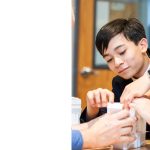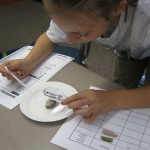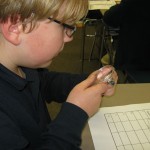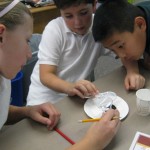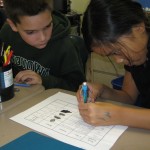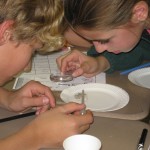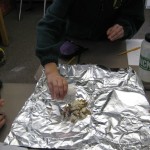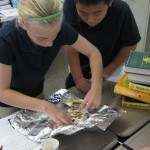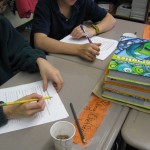Rocks and Minerals
Posted by Mary FaulknerFifth grade scientists are continuing with their robust and thought provoking investigations on how are earth changes over time. Three of our recent studies explored how these changes affect minerals and rocks. The first investigation focused on minerals and how scientists classify them. Students first tested six different minerals for their hardness using their fingernail, a penny, and a steel nail. Then, streak was found by rubbing each mineral against a streak plate (an unfinished tile) to observe the color of the powder left behind. Students were amazed to see that the streak often did not match the minerals’ color. Through the investigation students concluded that minerals can be classified using these two characteristics.
During the next investigation students tested various rock samples for the presence of calcite by putting a couple drops of vinegar on the sample and observing the reaction. Bubbling is an indication that calcite is present. After discussing what which types of rock contain calcite and that calcite is what most seashells are made of, the students concluded that sedimentary rocks most likely contained calcite! They also discovered that rocks are not so easily identified visually and further testing may be needed before they are categorized as sedimentary, metamorphic or igneous.
Our final investigation was a rock cycle simulation. Students were given chocolate, vanilla and butterscotch chips to represent three different samples of weathered rocks. The students then made a small pile in the center of a piece of aluminum foil, one type of rock at a time. After folding the foil into a package, students stacked several heavy books on the package for a few minutes. While the weathered rock samples were being compressed the students hypothesized what might be happening. The next step was to add heat and pressure, so students removed their shoes and took turns with group members standing on the package. Again hypotheses where made and the sample examined after a few minutes. Lastly, the package was put on a hot plate for one minute, completely cooled, then examined. The students excitedly realized they had just made sedimentary, metamorphic and igneous rocks, much in the same way they form over very long periods of time in the earth.
← With Every Season Junior Chorus Performance! →




